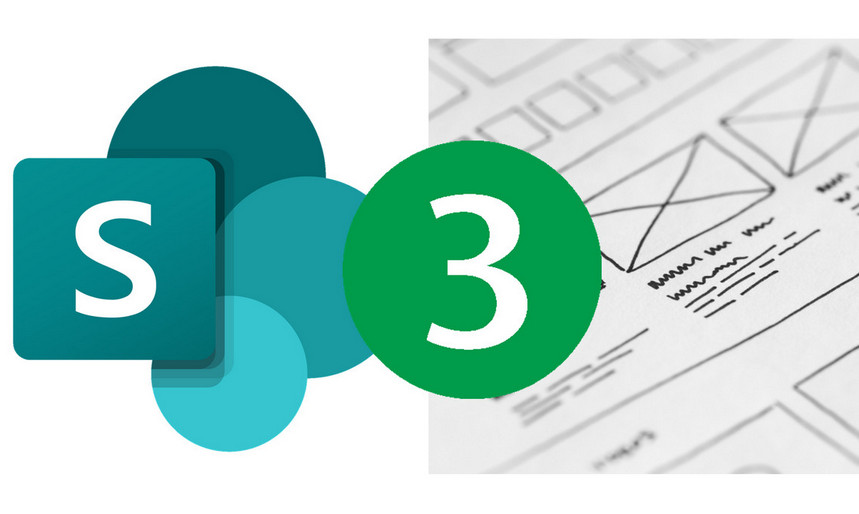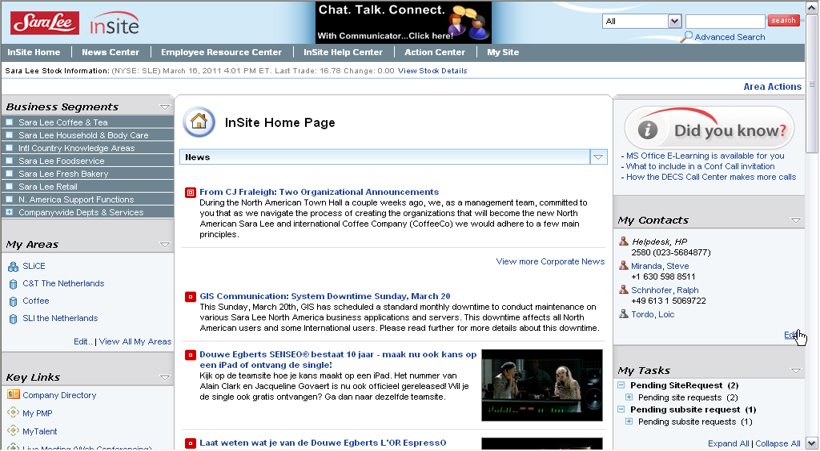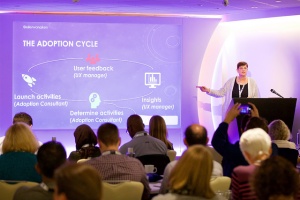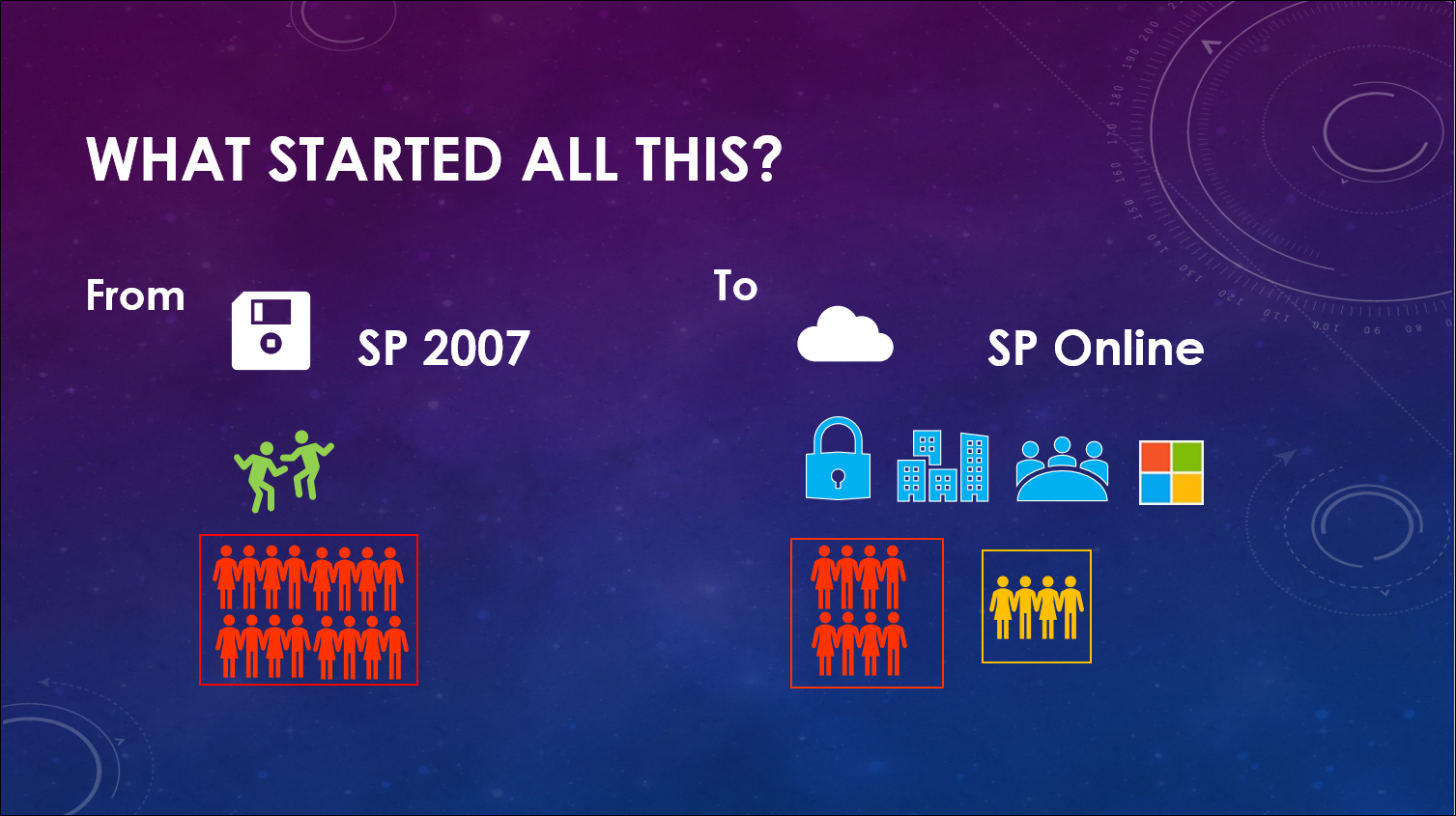This was also very likely my last! 🙂 Start and finish: 2021.
When I arrived at the scene, the organization had an intranet on an outdated, unsuitable platform. It was very complicated to create News and add pictures, content was outdated as it was quite a job to update stuff, and there was no interactivity at all.
The formal document management system (on the same platform) was cumbersome, the content outdated, the owner had left and nobody felt really responsible for that system.
On top of all that, there were considerable costs involved while we also had Office365, so it was only a matter of WHEN we would move to SharePoint Online and other Office365 applications, not IF.
Fortunately the project could start when I was still there and we would launch before I would retire.
This was a model project, quite unlike the two I had experienced before. In my first intranet we customized for functionality, in my second intranet we customized mainly for branding, and this one was a breeze: no customizations wanted or needed! Of course, SharePoint Online had evolved since I was involved in my second intranet, but there were a few other success factors as well:
1. Two projects: intranet and document management system
While I was trying to convince everyone that we really needed to start working towards SharePoint, I noticed that there was a lot of pushback. Gradually we understood that the governance model was unclear. We tried to help people see that the intranet and the DMS (document management system) happened to live on the same platform (at that time under one governance) but were two very different things. We needed to separate the two projects with different project teams and ownership.
My colleague was involved in the DMS, as this would be more complicated and she was expected to stay in the organization after my retirement, so it would save a handover. The intranet was simpler and I could easily document and transfer the knowledge to her.
So, from now on, this post will deal with the intranet.
2. SharePoint out-of-the-box
This was a strong wish from everyone involved. We did not think customization would be necessary for our requirements: News, formal information from various departments and processes, and an entry point into applications such as the HR system and the DMS.
We also wanted to avoid complexity, a longer timeline and costs.
3. Office365 was already in the organization
We did not have to worry about technical implementation, as we already used the Office365 suite. We needed to set a Homepage and make sure we could create Hubs, but those were only small adjustments.
Our colleagues were also already familiar with how things worked, so it was not a major change. We already used SharePoint sites for projects, departments and what not. Those would not be included into the intranet per se but could be linked to when needed.
4. Small project team
There were only three people involved in the day-to-day project management:
- The project manager and intranet owner from Communications. She was in charge of the content and design, and also liaised with the various stakeholders in the organization.
At launch she was responsible for Communications and training of News publishers and other colleagues. - An external Microsoft consultant who had created intranets before. He knew all the functional details, and he also brought experience from other organizations as to what worked and what not.
- And then there was me, who knows about SharePoint, but I did not have experience with Hubs and Homepages and Organizational Assets and those kinds of things. I was the liaison for IT-matters, and e.g. informed my colleague and our systems administrators what was happening, and which changes we needed to make in the system.
At launch, I was also involved in the training sessions.
This was very effective. No large meetings, no endless discussions, we shared progress with the organization and asked for their feedback and worked that into the new intranet.
5. No additional branding needed
After having worked for a number of brands, with branding customizations that were “absolutely essential”, it was very strange for me to notice that this organization (mental health care) was not really interested in branding. Every site beloning to the intranet has the intranet icon, and the DMS (called “Werkwijzer” aka “Work directions”) has its own icon, but that’s it.
Everyone can select their own Office365 top bar colour/pattern, we did not need the name of the organization in the bar, and the “default blue” SharePoint theme was close enough to the company colours. I tried to convince the project manager that we could easily change the theme to the actual blue from the corporate colours, but that was not needed.
6. No content migration
We decided not to migrate anything centrally. If a site owner wanted to move content from the old intranet to the new one, they had to do that themselves. We advised against copying, as most content was outdated. This led to some struggles with people who did not want to refresh their content, but the project manager insisted on at least a review and preferably a complete redesign to fit in the new setup, such as more picture materials and better use of page columns.
7. Guidelines for News and pages publishing
During training sessions of the future news and page editors we noticed that some people felt confused about all the options for visual display of their News and pages.
We decided to create some guidelines to help the publishers and keep things consistent. That post (from April 2022) got a lot of positive responses in the SharePoint/intranet community, so I guess this is interesting for other organizations as well.
8. A hard shut-down date for the old intranet
We needed to shut down the old intranet before November as the yearly bill was due then. We closed it down for employees three months before the pay date, but every publisher and content owner still had time to check if they had everything in their new site. The project manager warned everyone several times about the final shut-down date until it was finally gone forever.
What did not go so well?
Although nothing went wrong, we found that having many different News channels and publishers in one Hub site made the News part of the intranet a little crowded and overwhelming for some. Every News post is public, so a lot rolled up into the Hub, meaning a very short visibility time for each item on the Homepage. (Only 4 items were displayed at any given time)
Besides, some posts were duplicated as a re-post, and it was not always clear where a post originated. We spent some time fine-tuning the number of items, creating links to the Hub site, communicating how things worked etc. in order to improve.
Below is a screenshot of the Homepage just before I left (December 2021). You see it is standard SharePoint. It is all in Dutch, but I think you can guess what is what: Central news, the DMS, Events (including our Office365 webinars), the various intranet sites/departments, some highlighted items and links to various sites and applications.
Three months after launch it was decided to show more items on every page, to address the wishes from the organization, and to rearrange things a little. The screenshot below is from October 2022.
The News and Events are both a little longer, there are some (pink and green) highlighted organizational projects, changing every month, and the various external web sites have a separate row with yellow icons. This was all done by the intranet manager herself, no difficult customizations needed!
Now: Happy intranet manager and publishers
The intranet manager (the former project manager) informed me she is really happy with SharePoint. She finds it easy to work with and regularly makes small changes to the homepage herself, such as new buttons, or new highlighted items, to keep things fresh.
Furthermore, the news and page publishers like working with it, too! They inspire and stimulate each other to make posts and pages as nice and useful as possible. How cool is that!
Now: Proper governance
In the old intranet, both content, design and technical/system support for the intranet and the DMS were the responsibility of the Communications department.
Now, Communications is responsible for design and content of the intranet, while the DMS Owner is responsible for the design and content of the DMS.
ICT is responsible for technical and functional support for both.
Conclusion
All in all, we completed the project in about 6 months. It could perhaps have been done faster but things were a bit slow over the summer holiday period. Still, it was the shortest intranet project I have ever been involved in, and it was a most enjoyable last project. I could finally prove that customizations are not needed for a good intranet!
So, go for standard out-of-the-box SharePoint, folks! There are already so many options, and most of them have been well thought out for intranet use. No need to re-invent your own wheel!







 On October 5 I participated in IntranetNow in London. I presented there, and thought it would be nice to create a write-up in my blog, with some images from my presentation. If you prefer the PowerPoint variety, please
On October 5 I participated in IntranetNow in London. I presented there, and thought it would be nice to create a write-up in my blog, with some images from my presentation. If you prefer the PowerPoint variety, please 


 On October 5 I participated in IntranetNow, and a wonderful conference it was!
On October 5 I participated in IntranetNow, and a wonderful conference it was!




 Recently I have been helping to launch a new Office365-based intranet.
Recently I have been helping to launch a new Office365-based intranet.
